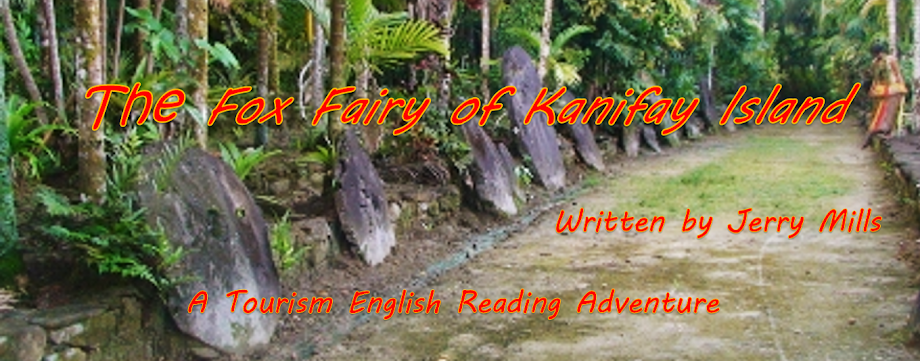Disclaimers
The Fox Fairy of Kanifay Island is written
for students of English as a Second Language/ English as a Foreign Language
(ESL/EFL), especially English Tourism classes in English for Specific
Purposes. The location is inspired by
the island of Yap, Federated States of Micronesia (FSM). I have tried to make the fictional Kanifay
Island as true to real life as the medium of storytelling will allow, but some
errors may have crept in. I welcome your
corrections, suggestions, and other comments.
Any photos or illustrations I may use in
this story are only for illustration.
They are not intended to accurately represent real people, businesses,
or institutions. The Department of
Safety is a fictional agency and is in no way intended to represent the
Micronesian government. The Hokkaido
Journal of Cryptozoology is a fictional medical journal, and the article
described in the journal is entirely a product of the author's imagination.
.
About
the Fox Fairy of Kanifay Island
Counting the title page, The Fox Fairy of
Kanifay Island is 19,358 words long, has three major characters, and uses basic
language. Most of the vocabulary words
are tourism vocabulary words. The
meaning of word exhibitionism is changed for the purpose of this story; the
word foxismonite was coined by the author.
The shortest chapter is around 1,300 words long; the longest is less
than 1,500.
Various legends of fox fairies are found
throughout East Asia, Europe, and among Native American tribes. All these legends are alike in some ways, but
they are different in others. The Fox
Fairy of Kanifay Island is one of many ways of telling the legend.
Main
characters:
Tony McCalla is a nineteen-year-old
university sophomore who is taking a six-week summer vacation to learn scuba
diving. Cindy Pialug is an
eighteen-year-old Kanifay islander who has plans to study at Ponape Island
State College in the fall. Dash Tobey is
a handsome action movie hero (in his early twenties) who often stars in movies
about scuba diving. Dash Tobey is on
Kanifay Island making a movie.
Off-screen, Dash Tobey owns a real, working ranch in Wyoming and flies a
helicopter that he sometimes uses to look for lost people in the mountains.
Summary:
Tony McCalla goes alone to Kanifay Island to learn
scuba diving for six weeks. After a
week’s stay at O’Malley’s Inn, he meets Cindy, who tells him about her neighbor
who offers a home stay. Thus, he becomes
Cindy’s neighbor, and they see each other several times a week. When Tony isn’t scuba diving or studying
scuba diving, he (sometimes with Cindy) enjoys the island’s attractions and
events. They include going to an old
Japanese airfield (with wrecked warplanes), watching cultural events, and
kayaking.
Unknown to Tony, and even to Cindy’s
neighbors, Cindy is a fox fairy. Each
night, from sunset until dawn, Cindy becomes a fox. The trouble is, foxes are not native to
Kanifay Island. They had been brought to
the island during the 1930’s and got out of hand. Since foxes are seen as harmful to native
plants and animals, the Department of Safety has been trying to kill all the
foxes on the island.
When Cindy has an accident and a doctor
discovers that she’s a fox fairy, several local people including the police
chief agree that she must be kept hidden until she can be sneaked from the
island. Since Kanifay Island had once
been an American territory, Kanifay islanders can move to the United States and
live there as long as they wish. A
flight to Guam appears to be their only way out. With only one flight a week going to Guam,
keeping Cindy’s secret is difficult.
The Department of Safety finds out about
Cindy and sends people to catch or kill her.
Cindy and Tony have to leave the island, but how? The Department of Safety already has its
people at the airport. As Cindy and Tony
try to reach the coast, where a friend has a small boat, they are trapped at
the old Japanese airfield. The
Department of Safety can do nothing to Cindy as long as she’s in her human
form, but darkness will come soon. Then
they plan to move in and kill her. How
can Cindy and Tony escape?
The final chapter gives brief glimpses of
Cindy’s college life, shopping with her host family, and other events during
which her secret is almost discovered.
At this writing, Cindy is in her second semester and has three more
years at Congaree University.
About
the Author of The Fox Fairy of Kanifay
Island
Jerry Mills is a retired teacher of
English as a Second Language (ESL) and has lived in Taiwan since 1992. In addition to Conversation, Grammar, and Composition, he taught several English for Specific
Purposes (ESP) courses, including Tourism, Advertising and Marketing,
Journalism, Business, and Literature.



























